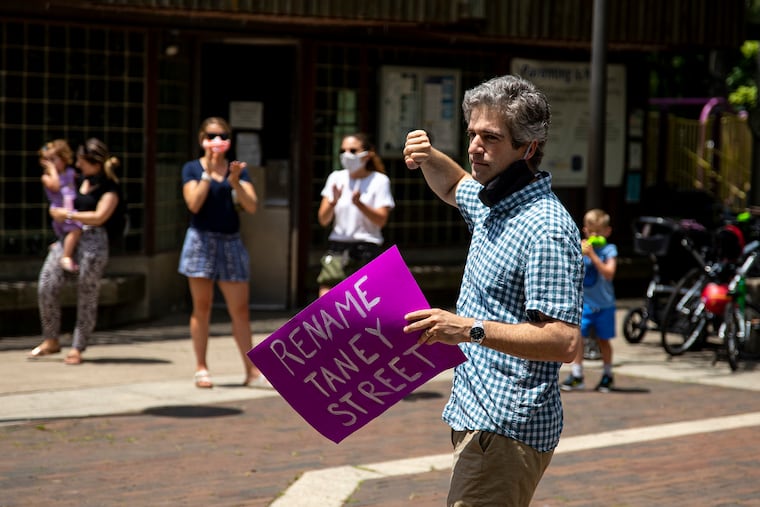Rename Taney Street in Philly is the latest campaign to erase a racist past
The street, which is in a number of city neighborhoods, is named for former U.S. Supreme Court Justice Roger Taney, the principal author of an 1857 decision which held that Africans, whether they were slaves or free people, had no standing in court.

In the latest action aimed at purging the symbols of racial intolerance and exclusion from America’s public spaces, protesters demonstrated along Fitler Square’s Taney Street on Saturday, calling on officials to rename it for someone who has united the nation rather than divided it.
The Philadelphia street, which is in a number of city neighborhoods, is named for former U.S. Supreme Court Justice Roger Taney, the principal author of the infamous Dred Scott v. Sandford decision of 1857, which held that Africans, whether enslaved or free, had no standing in court because they were not and could not be U.S. citizens.
“This grew out of a recognition that a lot needs to change in our society,” said protester Ben Keys, 40, a Taney Street resident and Wharton associate professor. “Culture needs to change as well as policies to make things more racially inclusive and make everyone in our communities feel welcome.”
About 40 people took part in the peaceful protest that started at Markward Playground.
“This really is an issue that’s emblematic of our time,” said Joshua Isserman, 40, president of the Fitler Square Neighborhood Association, one of the groups supporting the Rename Taney Street effort. “It’s only a start for the type of equity issues we need to start to really address with racism. Symbols are injurious to people, and they remind them of how the system cannot work for everyone.”
“The Mayor supports the effort to rename Taney Street,” a spokesperson for the city said. “Renaming requires City Council to introduce and pass an ordinance; the Mayor is not able to do this unilaterally.”
In addition to the Fitler Square group, the SOSNA civic group and 5th Square, an urbanist political action committee involved with sustainability and equity, are supporting the renaming campaign, Isserman said, along with individuals. Renaming advocates have an electronic petition with about 500 signatures, and another 200 paper signatures. They have been canvassing in some of the other Taney Street neighborhoods as well.
A Temple University student started a petition a few years ago on Change.org, but recent events have reignited interest, current organizers said.
» READ MORE: Systemic racism has affected all of us. Here’s how to start unlearning its harmful lessons | Elizabeth Wellington
The cities of Baltimore and Annapolis, Md., had statues of Taney which have been removed, they added.
Ever since the May death of George Floyd, a Black man killed when a white Minneapolis police officer knelt on his neck for nearly nine minutes, the country has been embroiled in a national reckoning over its history of racism. Many people have sought to have the symbols of that history exorcised, although not all have agreed what they are.
In Philadelphia, a statue of Frank Rizzo — a highly controversial former mayor and police commissioner reviled and yet still revered by some — was removed, and a mural of Rizzo in the Italian Market was painted over.
On Wednesday, the Delaware River Waterfront Corporation (DRWC) boarded up the bottom of the Christopher Columbus monument at Philadelphia’s Penn’s Landing.
The agency, which maintains the monument but did not build it, said in a statement that the statue “does not align with DRWC’s mission to create and maintain a safe and welcome space for all.”
The base of the statue, now covered with chalkboard, has drawn lots of handwritten messages such as “Black Lives Matter” and “Defund The Police,” along with pro-union scribes, names, and words like “justice” and “peace.”
DRWC indicated it will launch some public process to consider the statue’s fate, which could include removal.
» READ MORE: A Montco Republican commissioner called Black Lives Matter a ‘hate group.’ Now he’s more isolated than ever.
Another Columbus statue, in South Philadelphia’s Marconi Plaza, was the scene of three days of conflict recently as residents vowed to protect the statue, including some who were armed. Other protesters, who pointed to Columbus’ history of atrocities against indigenous people, alleged some police allowed the Columbus defenders to assault them. The incidents are under investigation. Wood casing was also put around that statue, reportedly to protect it while its future is determined.
And in Camden, Woodrow Wilson High School will be renamed this summer, school superintendent Katrina McCombs said earlier this week, citing the former president’s segregationist legacy. A committee of current Wilson students, alumni, and community leaders will decide on a new name.